Chikuzenni or Nishime is a simmered dish of tender root vegetables and chicken seasoned with a flavorful broth. A home-cooking classic, it’s also an important dish for the traditional Japanese New Year feast of Osechi Ryori served on New Year‘s Day. {Vegan Adaptable}
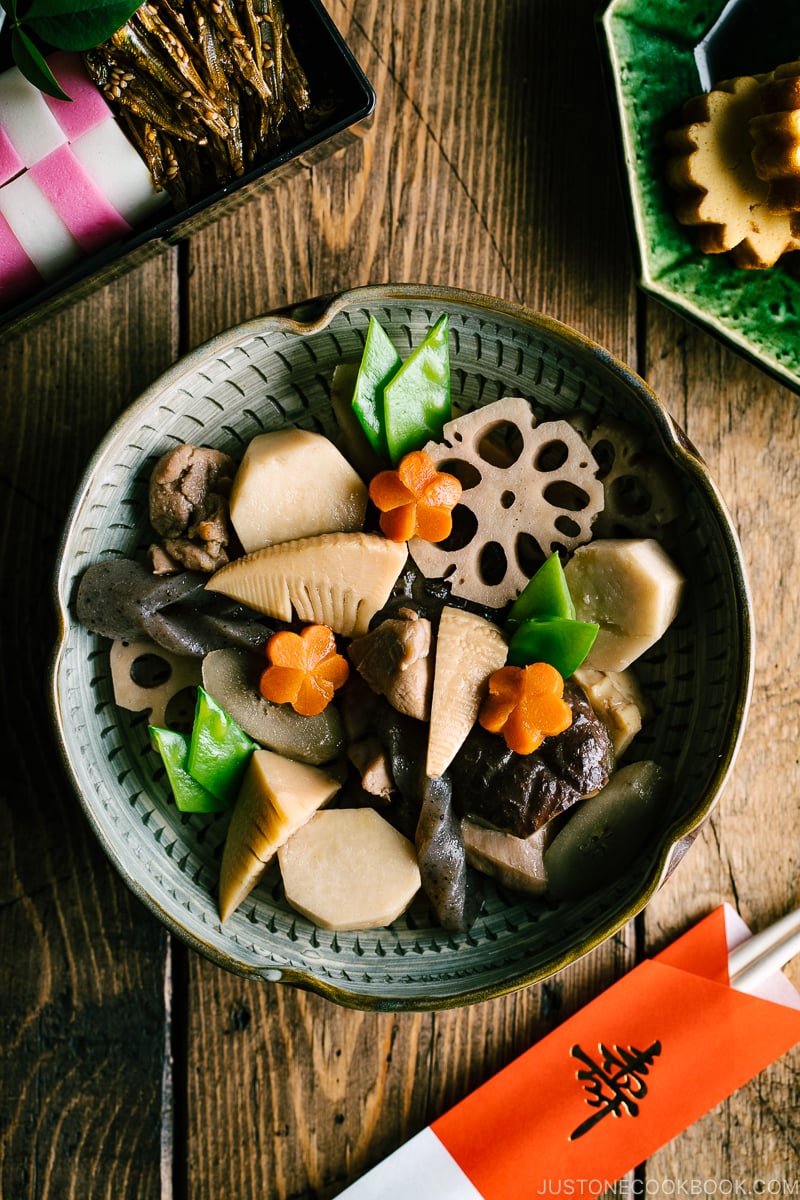
Chikuzenni (筑前煮) or Nishime (煮しめ) is a classic Japanese dish often served on New Year’s Day. This dish is made of root vegetables and chicken that are simmered in dashi, soy sauce, and mirin.
My mom used to make it quite regularly because it was my family’s favorite type of simmered dishes. This is also a popular side dish for bento because it can be made in advance and still tastes great at room temperature.
Table of Contents

What’s Chikuzenni?
Chikuzenni was named after the old Chikuzen Province in Northern Kyushu (it’s part of today’s Fukuoka Prefecture) and this dish originated there; however, it’s now enjoyed throughout Japan.
Typically, chicken and root vegetables are sautéed in oil first, then they are simmered in umami-rich dashi broth and seasonings until ingredients are tender and all the flavors are absorbed.
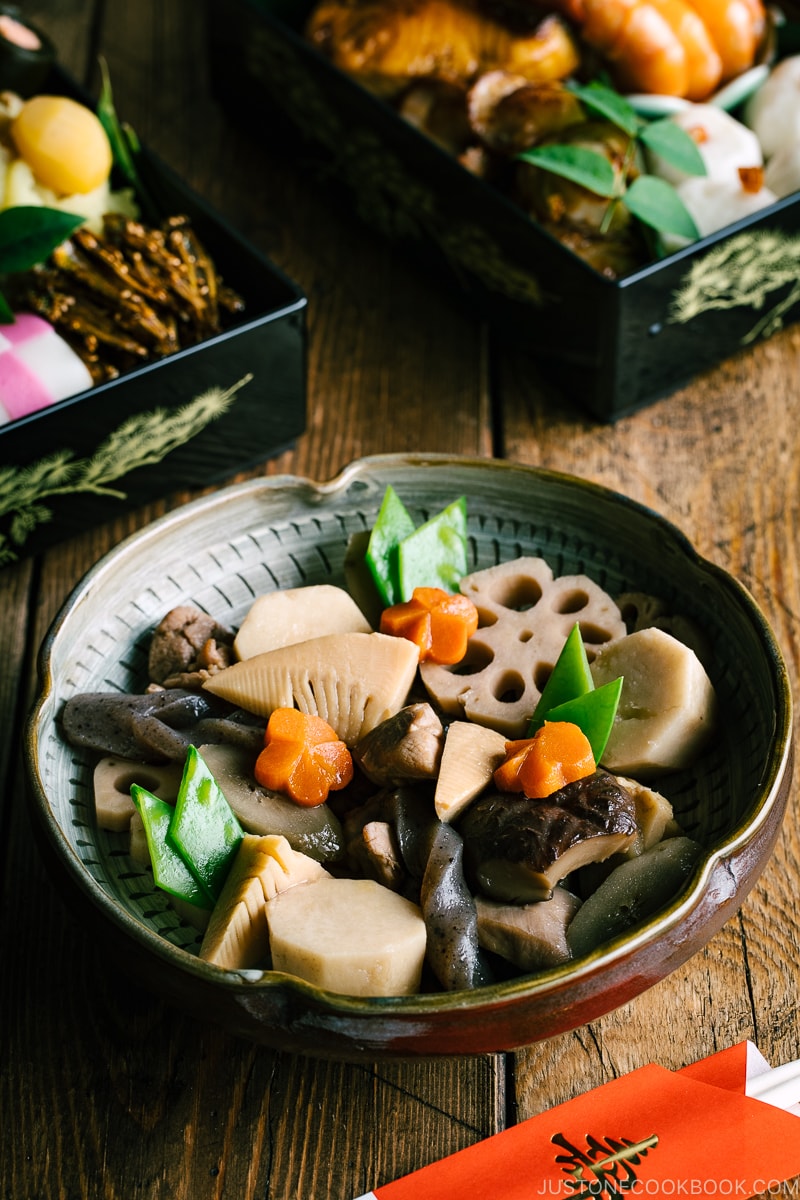
Decorative Shapes on Ingredients
For the New Year’s dish, the vegetables and konnyaku are cut into fancy shapes to celebrate the occasion but for daily use or bento, you can simply cut them into small pieces using a Japanese cutting technique called “Rangiri“.
Rangiri style cutting is to roll the vegetable a quarter turn, cut on an angle, and then roll again another quarter (¼) turn, cut on an angle, and continue. This cutting technique is useful for Japanese Nimono dishes.
Cook Faster: Pressure Cooker (Instant Pot) Nishime

If you want to speed up the process, you can use a pressure cooker (I used my Instant Pot) to make Chikuzenni or Nishime. You can click here for the recipe.
Hope you enjoy this dish with your family!

Wish to learn more about Japanese cooking? Sign up for our free newsletter to receive cooking tips & recipe updates! And stay in touch with me on Facebook, Pinterest, YouTube, and Instagram.
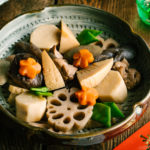
Chikuzenni / Nishime (Simmered Chicken and Vegetables)
Ingredients
- 6 dried shiitake mushrooms (1 oz, 30 g)
- 1 cup water (for the shiitake mushrooms and shiitake dashi)
- ¾ lb boneless, skinless chicken thighs (skip for vegan/vegetarian)
- ½ Tbsp sake (for the chicken)
- ½ Tbsp soy sauce (for the chicken)
- 5 taro (satoimo) (9 oz, 250 g)
- ½ boiled bamboo shoot (3 oz, 90 g)
- ½ gobo (burdock root) (4 oz, 110 g)
- 1 lotus root (renkon) (6 oz, 170 g)
- 1 Tbsp rice vinegar (unseasoned) (divided; for soaking the lotus root and gobo)
- 1 carrot (6 oz, 170 g)
- ½ block konnyaku (konjac) (4.5 oz, 130 g)
- 10 snow peas (1 oz, 30 g)
- ⅛ tsp Diamond Crystal kosher salt (for the snow peas)
- 1½ Tbsp toasted sesame oil (divided)
For the Seasonings
- 2 cups dashi (Japanese soup stock) (I used standard Awase Dashi, but you can substitute a dashi packet or Vegan Dashi; in a pinch, use dashi powder)
- 3 Tbsp sake
- 3 Tbsp mirin
- 1 Tbsp sugar
- 3 Tbsp usukuchi (light-colored) soy sauce (or use 2 Tbsp soy sauce + ⅛ tsp salt)
- ½ tsp Diamond Crystal kosher salt
Instructions
Before You Start…
- If you will include this dish in your Osechi meal, I recommend cooking it 2 days before you plan to serve. For more helpful tips on planning your Japanese New Year feast, please read my A 5-Day Osechi Cooking Timeline blog post.
- Gather all the ingredients.

To Prepare the Ingredients
★ Dried Shiitake Mushrooms
- Add 6 dried shiitake mushrooms and 1 cup water to a small bowl and soak for 20–30 minutes, or until tender and rehydrated.

- After 30 minutes or so, squeeze out the liquid from the shiitake mushrooms (reserve the soaking liquid).

- Cut off and discard the stems. Cut the shiitake mushroom caps into a hexagon (optional), which resembles a turtle shape and symbolizes longevity.
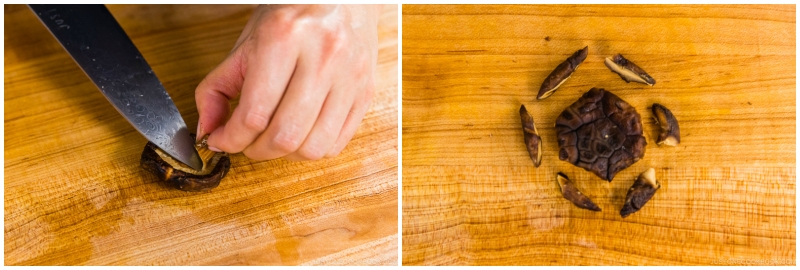
- Strain the shiitake soaking liquid through a fine-mesh sieve. This is called shiitake dashi. It yields roughly ¾ cup. Set aside.

★ Chicken
- Remove the extra fat and cut ¾ lb boneless, skinless chicken thighs into slanted pieces using the sogigiri Japanese cutting technique: Angle your knife back and diagonally (nearly parallel to the cutting board), and then slice the chicken into 1½-inch (3.8-cm) pieces. Tip: This method creates pieces of equal thickness and increased surface area, which allows the chicken to cook faster and absorb more flavors.
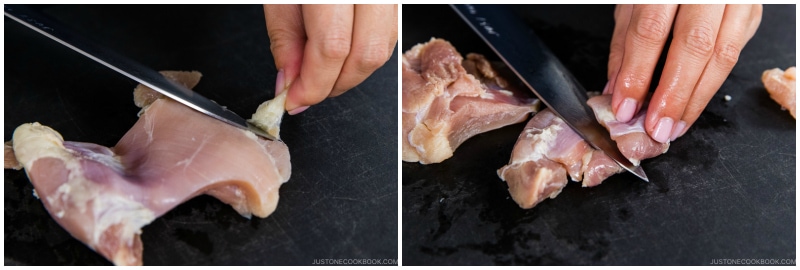
- Transfer the chicken to a medium bowl and add ½ Tbsp sake and ½ Tbsp soy sauce. Coat the chicken with the marinade and set aside.

★ Japanese Taro Root (Satoimo)
- Cut off the ends of 5 taro (satoimo). Then, peel the tough skin from one end to the other using a sharp knife. Tip: For taro, it’s recommended to peel the skin thick. It’s not considered wasteful to remove skin with more flesh attached.

- Ideally, taro should resemble a hexagon (with six sides) from the top view.

- Cut the taro in half and soak in water. You can rub them with salt to get rid of the sliminess, if you wish.

★ Bamboo Shoot
- Cut ½ boiled bamboo shoot into 4 pieces lengthwise.

- Cut the bamboo shoot pieces in half widthwise. If each piece is still bigger than bite-size, you can cut lengthwise in half again.

★ Burdock Root (Gobo)
- Scrape the skin off ½ gobo (burdock root) with the back of the knife. After rinsing, cut it into thin diagonal slices.

- Prepare a bowl of 2 cups water and ½ Tbsp rice vinegar. Soak the burdock root in the vinegared water for 15 minutes.

★ Lotus Root (Renkon)
- Peel off the skin of 1 lotus root (renkon) with a vegetable peeler or knife. Then, cut the root in half crosswise. (Optional) If you wish to make hana renkon (lotus root flowers), you can use my tutorial.

- The lotus root should resemble flowers after cutting the edges off.

- Otherwise, to make simple slices, cut the lotus root crosswise about ¼ inch (6 mm) thick. Prepare a bowl of 2 cups water and ½ Tbsp rice vinegar. Soak the lotus root in the water for 15 minutes.

★ Carrot (Nejiri Ume)
- Peel 1 carrot and cut into ½-inch (1.3-cm) rounds.

- Here, I‘ll show you how to cut the carrot into plum flowers (optional) using the Japanese cutting technique nejiri ume. Use a flower-shaped vegetable cutter and punch out a plum flower shape from the carrot rounds. Then, make a shallow incision (roughly ¼ inch or 6 mm deep) from the center of the flower to in-between the two petals.
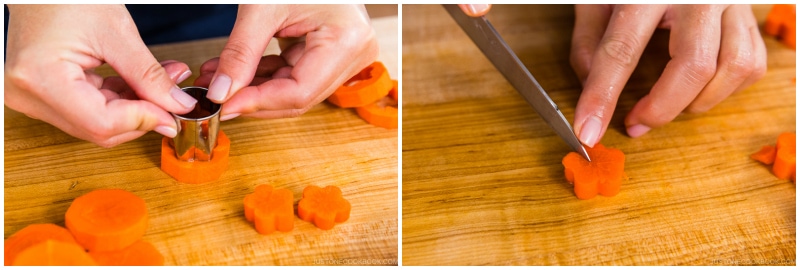
- Hold a knife parallel to one petal and make a diagonal cut from right to left in-between petals.
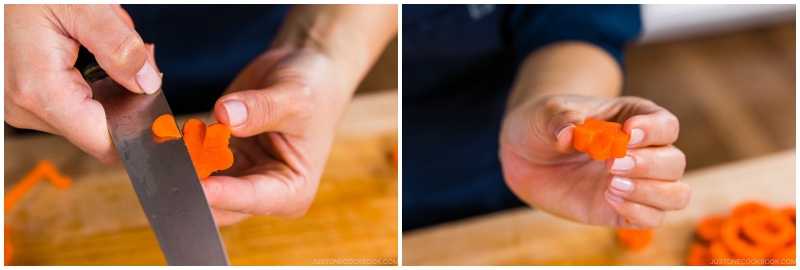

★ Konnyaku
- Cut ½ block konnyaku (konjac) crosswise into slices about ¼ inch (6 mm) thick. To make tazuna konnyaku (optional), cut a lengthwise slit 1½ inches (3.8 cm) long in the center of each slice.

- Then, tuck one end of the slice through the slit. Push it in; then, pull out the end from the other side. The konnyaku will now be twisted on either side of the slit to resemble horse reins. Pull gently on both ends so the slice lays flat. Repeat with the remaining slices.

★ Snow Peas
- Remove and discard the stem ends and tough strings of 10 snow peas.

To Blanch the Vegetables and Konnyaku
- Boil water in a saucepan over medium-high heat. Blanch half of the carrot flowers for 2 minutes and remove. Set aside for garnish.

- In the same boiling water, add ⅛ tsp Diamond Crystal kosher salt and blanch the snow peas for 30–60 seconds, until crisp but tender enough to eat.

- Remove the snow peas and transfer to a bowl of ice water to stop the cooking.

- In the same boiling water, add the konnyaku. Bring it to a boil again and cook for 2–3 minutes to remove the odor. Drain.

- Drain the blanched snow peas and cut them diagonally in half. Set aside for garnish.

To Make the Chikuzenni
- Heat a large pot over medium heat. When it’s hot, add 1 Tbsp of 1½ Tbsp toasted sesame oil. Then, add the chicken.

- Cook the chicken until it turns white. Transfer the chicken to a plate.
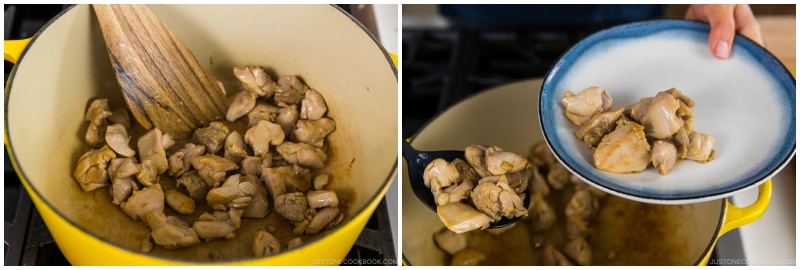
- Add the remaining sesame oil to the same pot over medium heat. Then, add the shiitake mushrooms, taro, bamboo shoot, gobo, lotus root, konnyaku, and other half of the carrot flowers. (Reserve the blanched carrots and blanched snow peas for garnish when serving.)

- Stir to cook and coat the ingredients with the sesame oil.

- Next, add 2 cups dashi (Japanese soup stock) and the shiitake dashi you made earlier.

- Bring it to a simmer over medium heat. Use a fine-mesh skimmer to skim off the fat and scum that accumulates on the surface.

- Add 3 Tbsp sake, 3 Tbsp mirin, 1 Tbsp sugar, 3 Tbsp usukuchi (light-colored) soy sauce, and ½ tsp Diamond Crystal kosher salt.

- Add the chicken back into the pot. Bring it to a simmer. As you see, the stock should cover about 80 percent of the ingredients.

- Put an otoshibuta (drop lid) on the ingredients and cook for 10 minutes. If you don‘t have one, you can make an otoshibuta with aluminum foil.

- After about 10 minutes, remove the otoshibuta and cook for another 10 minutes until tender.

- Insert a bamboo skewer into the tough vegetables (taro and lotus root) to see if they are tender. Taste and adjust the seasonings if needed.

To Serve
- Remove from the heat. Cover and let cool. Transfer the cooled Chikuzenni to a serving dish or Osechi box. Garnish on top with the blanched snow peas and blanched carrot flowers. Enjoy!

To Store
- Keep the leftovers in an airtight container and store it in the refrigerator for up to 5 days. The flavor will intensify as time passes, so if you plan to serve it later, you may consider reducing the amount of seasoning. Nishime also freezes well, but the konnyaku texture will change, so I recommend removing them before freezing. Defrost overnight and reheat in a pot.
Nutrition
Editor’s Note: This post was originally published on December 26, 2012. It’s been updated with new images in 2019 and republished on December 27, 2023.









Can we re-use the simmered liquid for other dishes? if so, any dish ideas?
Hi Vikky! You may use the liquid to cook simmered potatoes or taro.
https://www.justonecookbook.com/simmered-taro/
We hope this helps!
I have a considerable amount of liquid left in the pot. I will store it in the fridge for 2 days in the liquid, but how do I serve it? Boil the liquid off? Strain out the solids and present that way? Mine looks quite soupy/stewy which doesn’t seem correct.
Hello, Beverly. Thank you very much for trying Nami’s recipe!
Did you use Otoshibuta? It sounds like the liquid did not evaporate during the cooking process.
You can continue to cook without the lid for a few minutes more, but if the veggies are fully cooked to your liking and have your preferred flavor, you may remove the liquid and just serve the Chikuzennni.
We hope this helps!🤗
Perfect!! five stars .
By the way, can I freeze it?
Hello, Lisa! Yes, you may put it in the freezer. However, freezing changes the texture of the konnyaku, so we recommend removing them before freezing. Chikuzenni can be defrosted overnight and reheated in a pot.
We hope this was helpful! Thank you for trying Nami’s recipe!
Hi, what is the purpose of soaking the cut lotus root and burdock root in vinegar solution? Can I just rinse them in water? Thanks!
Hi Emily! Thank you very much for trying Nami’s recipe!
The vinegar keeps the color of the cut lotus and makes it crunchy.
We hope this helps!
I just made this as my first attempt at Japanese cooking! I had to substitute a lot of ingredients because I couldn’t find them. But it was turned delicious! I had to go with Jicama instead of Lotus, and Eddoh instead of Taro etc. Very good instructions! Thank you so much!
Hi Jess, Wow! Thank you very much for trying this recipe!
We are so happy to hear it turned out great with substitute ingredients. Thank you for sharing your cooking experience with us!
This year I decided to make more than just ozoni this year. Last year I also made chikuzenni, using this recipe. I used this one and many others from your osechi recipes for my first attempt of many of the dishes because of your step by step instructions in English. So thank you for helping me kick off the new year with a Japanese flair other than buying osechi (that had been many many years ago!) with traditional recipes rather than the popular yohoku dishes I know how to make.
Hi Gena,
Aww…Thank you very much for making Osechi using Nami’s instructions and recipes!
We are so glad to hear that step-by-step English instructions are beneficial, and you could complete the Osechi menu! Yay!
ARIGATO.. This helped me greatly in making a COVID New Year feel like one that my mother used to create for us. Next year if I’m not in Japan, I’ll try all your osechi recipes as I can’t read my mother’s recipes.
Hi Joyce!
Aww… We are so happy to hear this recipe brought joy to you! ☺️
Thank you very much for trying this recipe and for your kind feedback.
Excellent recipe and easy to follow 😀
Hi Helny! I’m so glad to hear you liked this recipe. Thank you for your kind feedback!